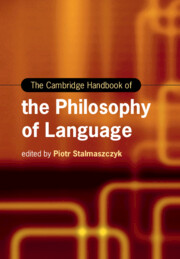Book contents
- The Cambridge Handbook of the Philosophy of Language
- Cambridge Handbooks in Language and Linguistics
- The Cambridge Handbook of the Philosophy of Language
- Copyright page
- Contents
- Figures
- Tables
- Contributors
- Preface
- 1 Philosophy of Language: Definitions, Disciplines, and Approaches
- Part I The Past, Present, and Future of Philosophy of Language
- Part II Some Foundational Issues
- Part III From Truth to Vagueness
- 11 Truth and Theories of Truth
- 12 Reference and Theories of Reference
- 13 Names in Philosophy
- 14 Indexicals and Contextual Involvement
- 15 Natural Kind Terms
- 16 Vagueness in Natural Language
- Part IV Issues in Semantics and Pragmatics
- Part V Philosophical Implications and Linguistic Theories
- Part VI Some Extensions
- References
- Index
15 - Natural Kind Terms
from Part III - From Truth to Vagueness
Published online by Cambridge University Press: 12 November 2021
- The Cambridge Handbook of the Philosophy of Language
- Cambridge Handbooks in Language and Linguistics
- The Cambridge Handbook of the Philosophy of Language
- Copyright page
- Contents
- Figures
- Tables
- Contributors
- Preface
- 1 Philosophy of Language: Definitions, Disciplines, and Approaches
- Part I The Past, Present, and Future of Philosophy of Language
- Part II Some Foundational Issues
- Part III From Truth to Vagueness
- 11 Truth and Theories of Truth
- 12 Reference and Theories of Reference
- 13 Names in Philosophy
- 14 Indexicals and Contextual Involvement
- 15 Natural Kind Terms
- 16 Vagueness in Natural Language
- Part IV Issues in Semantics and Pragmatics
- Part V Philosophical Implications and Linguistic Theories
- Part VI Some Extensions
- References
- Index
Summary
The notion of reference can be conceived as a dyadic relation between an expression and an entity or a set of entities; these entities, which will be usually extralinguistic, are the referent of the expression. Nonetheless, it is relevant to make two qualifications. On the one hand, the term reference is very often used ambiguously, since it frequently occurs instead of the expression referent; however, the context will help avoid possible misunderstandings. On the other hand, reference can be understood not as a dyadic relation between a linguistic expression and its referent, but as a triadic relation between speakers, an expression and the referent. Nonetheless, we will not emphasize this distinction, since the assertions about the reference of expressions could be paraphrased as ones about the speakers’ use(s) of them in order to refer.
- Type
- Chapter
- Information
- The Cambridge Handbook of the Philosophy of Language , pp. 283 - 299Publisher: Cambridge University PressPrint publication year: 2021
- 1
- Cited by

